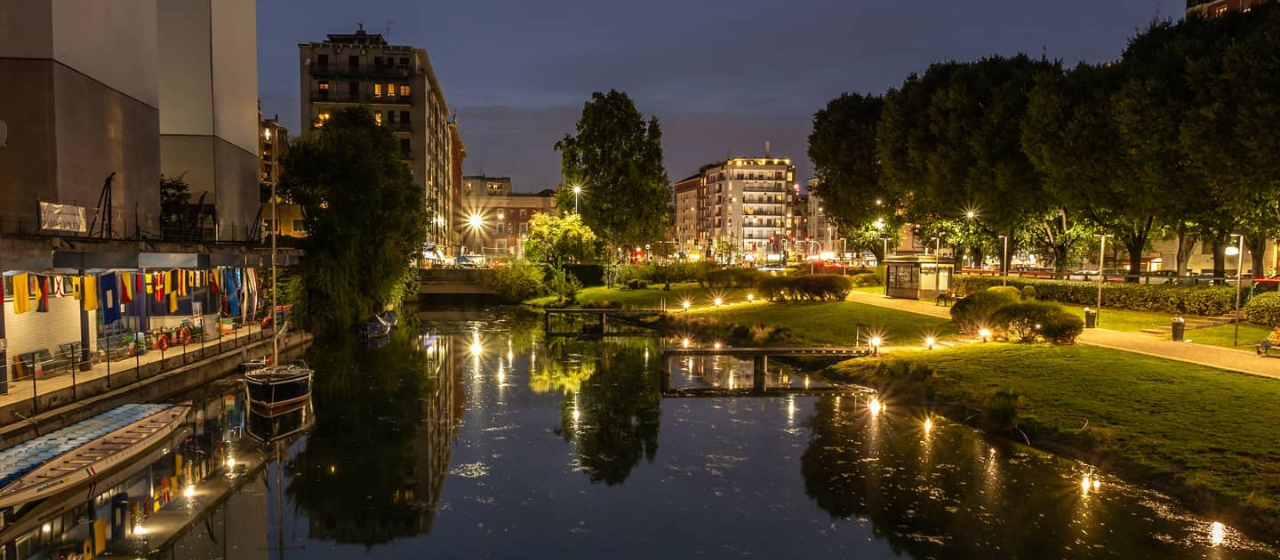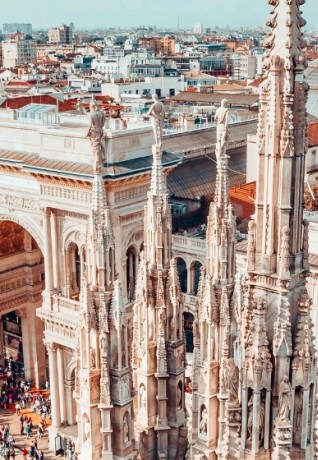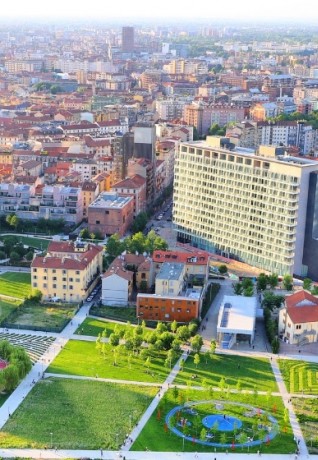The Southern half of the city was traversed by canals and dominated by agrarian fields and cottages. Traditionally plebeian and shrouded in fog, this is where the city has expanded the most since the 1980s, with Ticinese and the Navigli emerging as the most popular nightlife destination for Milano’s youth. It is also where the Prada Foundation is located and the most important urban transformation projects are taking place, in the Lodi-Scalo Romana area which will host the Olympic Village and the Rogoredo area which will host the Olympic Hockey Arena for the 2026 Winter Games.
HOW TO GET THERE
Metro M2 Green: P.ta Genova, Romolo – Metro M3 Yellow: P.ta Romana, Lodi T.I.B.B., Brenta, Rogoredo FS
NAVIGLI - TICINESE
The Navigli are two fresh water canals that enter the city from the South and South-West: the Naviglio Grande and the Naviglio Pavese, which converge near the Porta Ticinese gate. This is where Mianese and visitors spend their leisure time, around the beautifully renovated Darsena, Milano’s ancient river port.
Porta Cicca, as Porta Ticinese was traditionally called in Milan, was home to an underground world of poverty, hard work, crime and prostitution until the 1950s. In the 1980s the Ticinese definitely changed skin, becoming the favorite destination for those looking for music and socializing.
Many young professionals with their families have moved here, and the neighborhood is the symbol of the urban rebirth of Milan, in which the renovation of the covered market in Piazza XXIV Maggio by the Darsena stand out. It is now a global food market with a dense quay of bars and restaurants and a pedestrian bridge that crosses the basin. The area can be reached by either tram (lines #3, 9, 10, 14) or subway (M2 P.ta Genova).
WHY GO THERE
There is nothing more Milanese than an evening on the Navigli. Certainly the most photographed district of the city with its iron and concrete bridges immortalized at sunset.
Youngsters and teenagers flock to the Naviglio Grande in the evening, when the two pedestrianized banks of the canal built start filling with life, at outdoor tables where they serve spritz and chupito. Every last Sunday of the month, the Navigli canals host the Antiques Street Market, an unmissable event for all vintage enthusiasts looking for paintings, furnishings, decorative and collectible items. Beyond piazzale Negrelli there is a cycle path that leads to Trezzano sul Naviglio, which can also be reached by bateau mouche.
To do alternative shopping in Corso di Porta Ticinese, riddled with boutiques and food venues. To visit the Vicolo dei Lavandai, where you can still see the wash houses where until the last century hundreds of women washed the clothes of the wealthy.
TORTONA - SAVONA
The area behind Porta Genova is a former industrial district of large factories with water tanks on their roofs, which has synonymous with designer firms and fashion showrooms. Welcome to the design district, which rises over the bridge (now a walkway) behind the Porta Genova station, in the area compried between via Tortona and via Savona.
The neighborhood is the home of Milanese industrial design and hosts the Fuorisalone (next edition will be held in September 2021). The Fuorisalone was born here to complement the Salone del Mobile (the international furniture fair at Rho-Fiera) and attracts talent from all over the world, with people flocking to the ateliers of Milanese designers that are open to the public for the occasion, to take part in presentations, debates, vernissages, parties, street art and DJ performances.
WHY GO THERE
Two new Milanese cultural institutions were born in the huge area that used to host the Ansaldo works.
The first is the MUDEC, the Museum of Cultures inaugurated in 2014, located in a hypermodern structure with an iridescent color at the end of via Tortona, which houses a permanent collection of works of art and artifacts that cross the ages and the ethnic cultures of the world , with a calendar of very popular exhibitions (the next scheduled: "Disney. The art of telling timeless stories" which will be followed by "Robot. The human project").
The second is BASE, the multifunctional space opened in 2015 where you can breathe creativity in every corner and which functions both as a coworking area and as a place to organize workshops and symposia on social, cultural and technological innovation.
Also on via Bergognone there are the four floors of Armani Silos where the historical fashion creations of Giorgio Armani, the Milanese designer par excellence, are collected.
The green lung of the neighborhood is Parco Solari, with its stylish indoor pool which in summer hosts an outdoor cocktail lounge very popular with international students living in Milan.
Porta Romana is a middle-class neighborhood close to the Spanish walls and bordered to the north by three historic gates: Ludovica, Vigentina and Romana. It is also one of the most beautiful and enjoyable districts of the city, also for nightlife. Populated by professionals and students, it contains a food district with some of the most delicious yet affordable restaurants and wineries in Milano.
The area between Piazzale Lodi and Piazza Trento (A2A area) is undergoing profound transformation. The recently approved masterplan provides for the construction of a large park with woods in which the Olympic Village for the Milan-Cortina 2026 Winter Games will be located, in the railway yards of the Scalo Romana, reachable from Piazzale Lodi.
Scalo Romana together is one of the emerging districts of the city. As Mayor Sala has repeatedly pointed out, the urban future of Milan passes through here.
HOW TO GET THERE
Metro M3 Yellow: Crocetta, P.ta Romana, Lodi T.I.B.B., Brenta, Rogoredo
WHY GO THERE
You can also find cafes and bookshops, a lively weekly market in via Crema (on Friday - yellow metro, Porta Romana stop). Beyond Piazzale Lodi, there is the sophisticated complex Fondazione Prada (M3 Brenta), a unique institution in the city with large art exhibits and screen projections devoted to international contemporary art.
The daytime meeting place of the neighborhood is Piazza Medaglie d’oro at the intersection with Corso Lodi. Riders charge their phones and wait for delivery orders outside fast food restaurants; friends meet for lunch at the bookstore/café at the corner with via Sabotino.
Porta Romana is a young and lively neighborhood, full of espresso bars and coworking spaces. Many theaters contribute to the cultural vibrancy of the area, including the Franco Parenti, which stages classical and contemporary performances.
For the Prada Foundation in Largo Isarco, the largest and most recent institution of contemporary art in Milan. A large complex where the bar designed by director Wes Anderson and the enormous space for exhibitions and screenings stand out, the Foundation is a place of cultural sophistication and artistic research that has become in a few years an international reference for the visual arts and a popular tourist destination for visitors and female visitors from all over the world.
The district of Giambellino and its "twin", Lorenteggio, represent the most authentically popular Milano since the years of the postwar economic miracle.
Reachable from the Navigli and Porta Genova, the district stands out for its good services and convenient trams to the center and the multitude of shops, clubs and restaurants, as well as the local market.
The M4 subway line, which is scheduled to open in 2023, will have a “Giambellino” stop. Until then, you can get to the neighborhood hopping on tram 14.
A large neighborhood west of the center, Bande Nere is mainly inhabited by middle-class and white-collar workers that lies on the red metro line. The district develops around the three large roundabouts of Piazza Frattini, Piazzale Giovanni dalle Bande Nere and Piazza Siena. Mainly residential, the neighborhood has no shortage of surprises in terms of ethnic cuisine, especially kosher, Japanese and Korean.
HOW TO GET THERE
Metro M1 Red: Gambara, Bande Nere, Primaticcio – Metro M4 Blue (to be completed)
WHY GO THERE
The Jewish Quarter south of Piazza Bande Nere is a place with a unique atmosphere in the city, especially during holidays such as Rosh Hashanah and Hanukkah. It extends as far as Via Washington and secular Jews and Hasidic communities live here. The presence of kosher restaurants is very strong and the settings of bars and diners range from ironic to exotic. It is also the only place in Milan where you can savor bagels and pastrami like in New York City!
For the Giambellino covered market and the community gardens around it. Many are projects for the refurbishment of squares and gardens, also thanks to the initiative of neighborhood associations, such as the Casetta Verde near the Lorenteggio Library, while Renzo Piano's team is working on the entire redevelopment of Giambellino on behalf of the city administration.
The quadrilateral between via Lorenteggio, largo Gelsomini, via Giambellino and piazza Tirana is being renovated thanks to the ew municipal plan, and works are underway to make the area more walkable and pleasant, including the complete renovation of the Largo Giambellino gardens, a green expanse of more than 9000 square meters.
A piece of early medieval history survives in the middle of the neighborhood: it is the oratory of San Protaso al Lorenteggio, a tiny church dating back to the year 1000. It is only open on special festivities, during which it is possible to participate in guided tours.
Piazzale Gambara is the place where cafes, pizzerias and supermarkets are concentrated. The circulation of traffic is slowed down by flower beds with lavender and Via Antonello da Messina is placid and tree-lined.

 Log in
Log in


